Ainu: a long way through the centuries
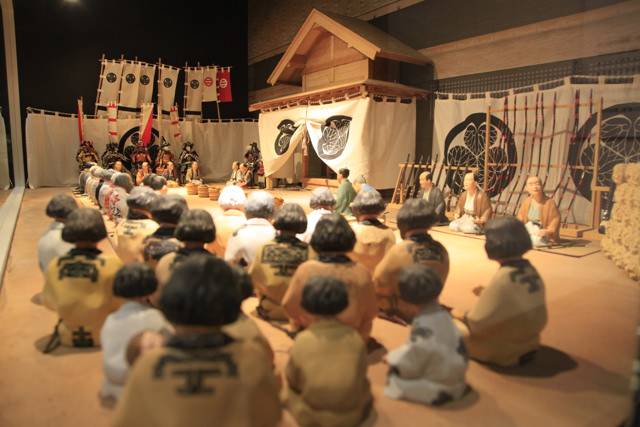
Omusha. This diorama from the Aibu Museum of Nibutani in the city of Biratori recreates omusha, which occurs in the Aizu clan on Sakhalin in 1808. At first it was a celebration of meeting old friends or acquaintances, but gradually it was transformed into a political ceremony, during which rice, sake and tobacco were delivered to the Ainu, and the shogun's envoy read out new edicts. The Ainu elders sat in front of the house, and the messenger addressed them through an interpreter. The ceremony was usually followed by a banquet.
Nihon Shoki. Japanese Chronicle 720
At the crossroads of civilizations. This material would have appeared on VO, as I promised to write it back in 2015. They are waiting for the promised three years, but here the expectation has stretched for as many as five years. But thanks to the perseverance of one of the participants in “VO”, the business moved forward and this article appeared. It is quite possible that it will be the beginning of a new cycle - because at the crossroads of civilizations in the past and in the present there was and there is much that can and should be told about.
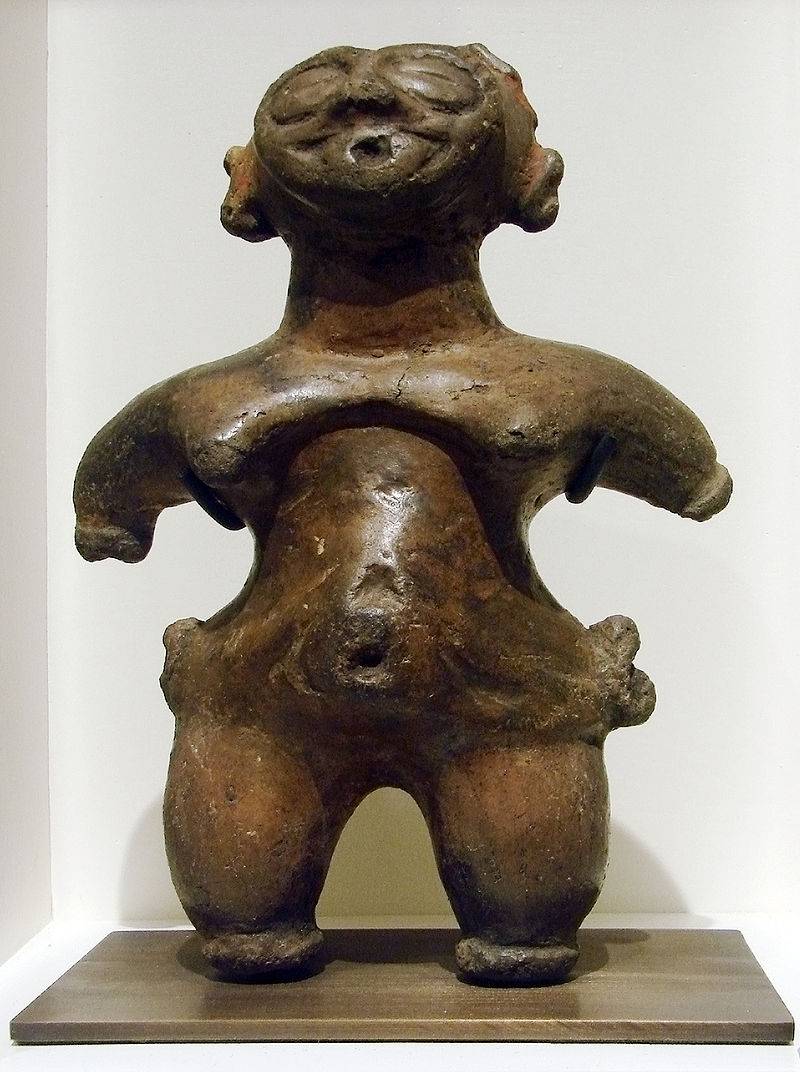
Dogu: "clothes that close with the head." Belonged to the Neolithic culture of Jomon. One of the female dogu statuettes from the Paris Guimet Museum. It was these figurines that became the source of insinuations about the meeting of the ancestors of the Japanese with alien aliens
So Ainu. It is written about them in all books devoted to stories samurai, and in all these books reports about them are very abrupt.
For example, Samurai Mitsuo Kure. In the “Introduction” it is said that the government of Kyoto in the VI-VII centuries was engaged only in trying to break the resistance of emisi (ebisu), “barbarians” from the north of Honshu, who were experienced equestrian warriors and archery. And that prisoners and allied emissi often acted as mercenaries, protecting Kyushu from the invasions of the Chinese and Koreans, and even acquired all the rights of the samurai. And many noble clans just descended from the Emisi prisoners, as evidenced by the endings "be" in their names, indicating their status as prisoners or slaves - Abe, Mononobe, etc. The very word emishi (ebisu) is translated as "shrimp barbarians", that is, "shrimp eaters", but at the same time that this word is derived from Ainu emchu or enchu, which means "people", as well as Japanese e-fly - "Brave warriors." They were also called “hairy barbarians”, which makes them similar in description with the Ainu who are of interest to us, who were also “hairy people”. But are Ainu and Emisu the same thing or not? There is still no exact answer to this question. It is only known that when the ancestors of the Japanese, who belonged to the Altai language group, arrived in Japan, it was already settled. And they had to beat literally every patch of land suitable for rice cultivation from the natives, that is, they had to fight continuously. And the "Japanese" attacked the Aboriginal Emis, and the Emis attacked the "Japanese" in response.
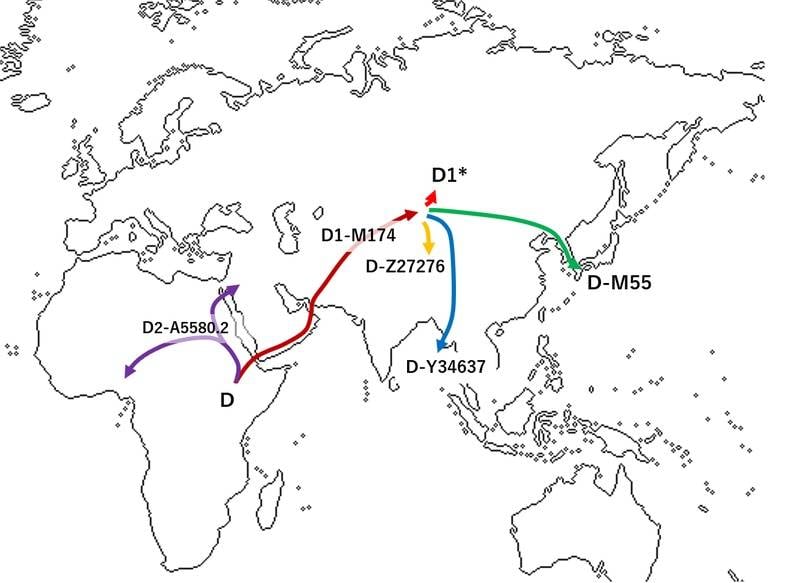
Haplogroup D migration
The advantage was on the side of the latter due to the fact that their social organization was significantly higher in level. They already had a written language and a state, and the Emisu lived in a tribal system and did not know a written language. As a result, by the XNUMXth century, the "Japanese" captured the entire territory of Emisu's residence, except for the island of Hokkaido.
In general, it is believed that archaeological evidence suggests the closeness of the Emishi culture and the Neolithic culture of Jomon - this is, firstly. And, secondly, that it is close to the medieval culture of the Ainu that interest us. This allows us to consider emisi as a kind of intermediate link in the evolution of the indigenous population of the Japanese islands from the Neolithic era to modern Ainu. That is, the “hairy barbarians” of the Emisi are, as it were, the ancestors of later Ainu, and also “hairy”. But the latter were no longer horsemen, but fishermen and hunters, although they, of course, accurately shot from bows.
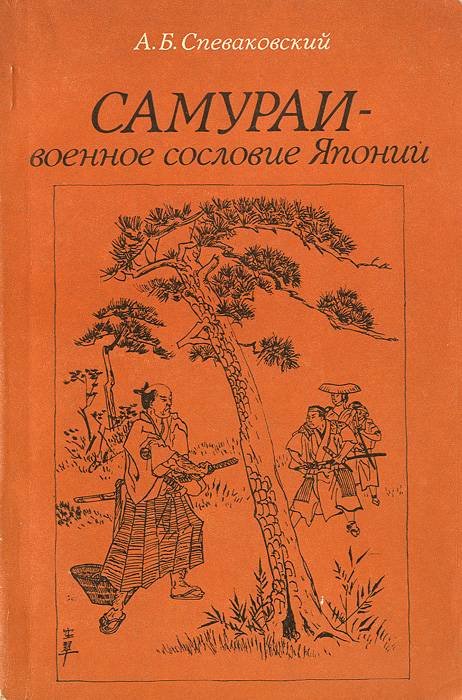
Book of A. B. Spevakovsky
According to the Soviet historian A. B. Spevakovsky, the newly arrived Japanese borrowed a lot from the same Ainu, including the ritual of “revealing the soul,” that is, hara-kiri. In his monograph Samurai, Japan’s Military Estate, Ezo (another name for Emishi) is the Ainu who lived in the north-east of the country and were forced out to the island of Hokkaido. That is, it can be considered that emisi (ezo) are either Ainu proper, moreover, very warlike, or some ethnic community, then transformed directly into Ainu. Well, modern historiography considers emisi a proto-Ainu community. That is such a “science” that is so complicated today for us, connected with this people.
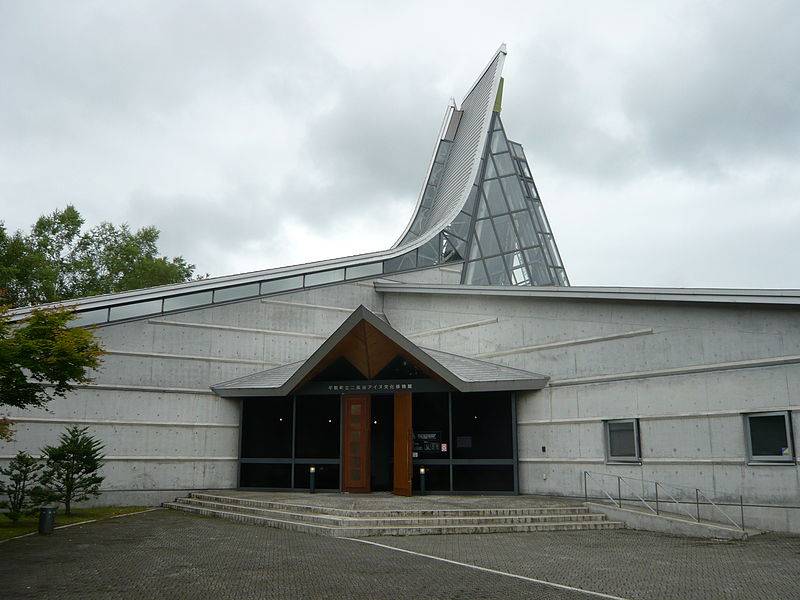
The building of the Museum of Ainu Nibutani in the city of Biratori
As for the Japanese museums, (referring to the museums of the island of Hokkaido dedicated specifically to the Ainu), they are reported there almost everywhere the same thing: the Ainu are the indigenous population of Japan. In the Ainu language, “Ainu” means “human being”, that is, as it often happened to the culture of various nations, their self-name was identical to the concept of “people”. Ainu lived not only in Hokkaido, but also on Sakhalin (the Japanese name Karafuto), and on the Kuril Islands.
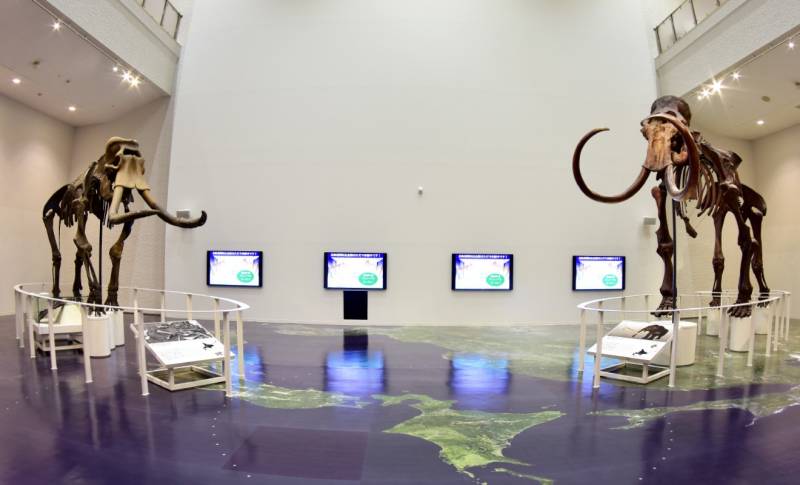
The decoration of the Nibutani Ainu Museum in Biratori is very modern. The exposition emphasizes that the island of Hakkaido for thousands of years has been a real crossroads of cultures. Mammoths came here from the north, and “Naumann elephants” from the south. Among the fossils, it is their teeth that are found most often
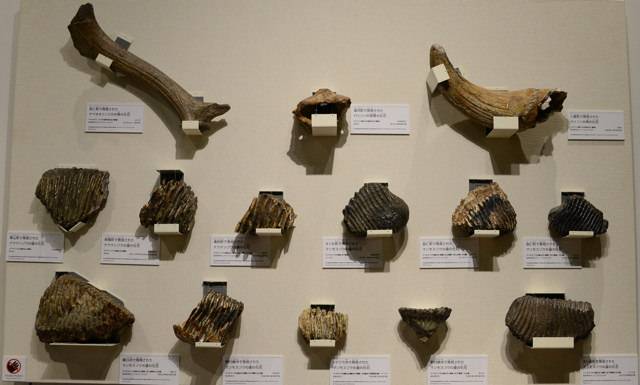
Here they are - these teeth!
Japanese scientists attribute the Ainu culture to the so-called Okhotsk culture, which between the XNUMXth and XNUMXth centuries spread from Sakhalin through the Sea of Okhotsk to the Kuril Islands and the coast of Hokkaido, where they began to produce unique ceramics. However, a legitimate question arises, what was before this time and where did the Ainu come from on the islands of the Japanese archipelago and on the mainland. After all, if their culture correlates with the culture of the Jomon period, then this is such a hoary antiquity that little can be said about it at all.
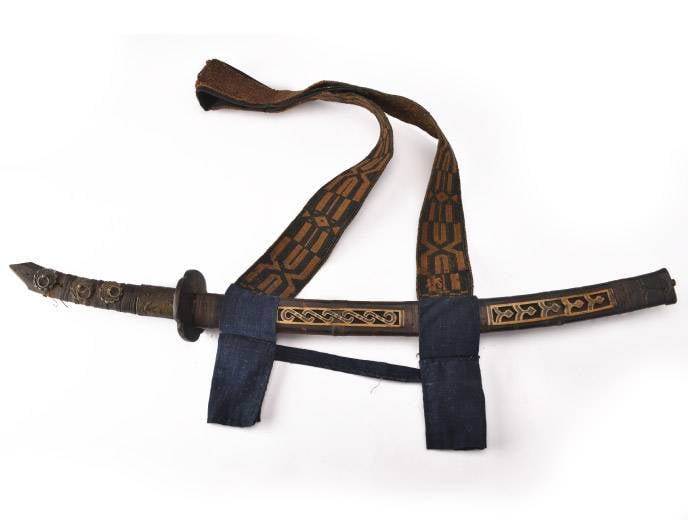
But this is the Ainu sword. Who didn’t borrow from anyone now ...
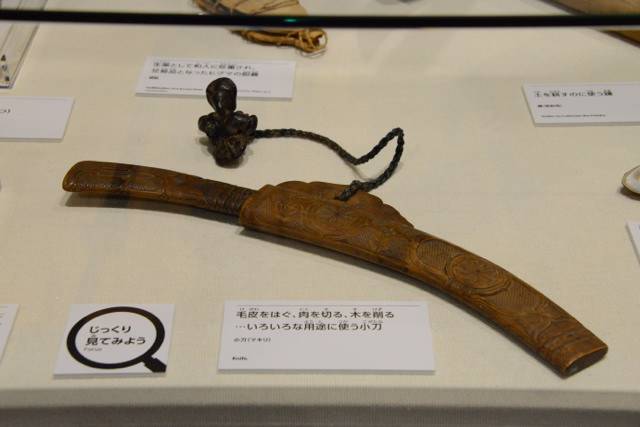
Makiri is a knife that is used not only for cutting, but also for scraping hides and cooking. Beautiful patterns are an indispensable attribute of the hilt and scabbard. Makiri was so convenient that the Japanese used it, and this made it a popular commodity.
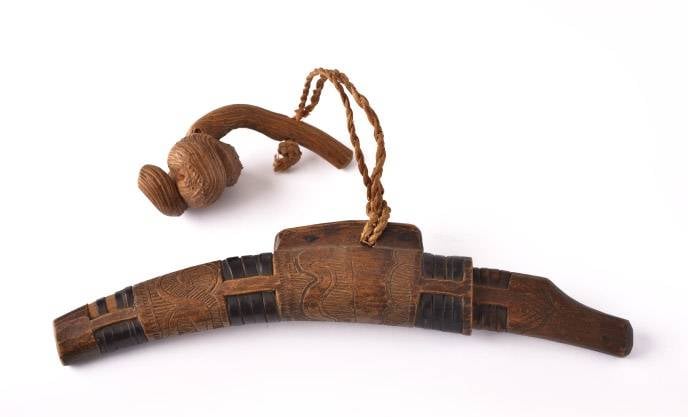
Menokomakiri - Ainu female knife
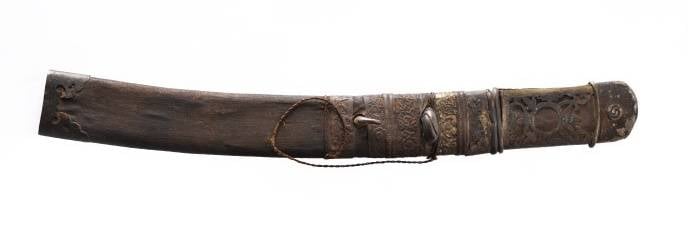
Tacunepicoro - a short sword
We know about this time only from archaeological artifacts, but no more. The Ainu themselves can tell us a little. After all, they did not have a written language and all that they know about their past is just legends and traditions. And then, the Japanese practically did not study them in the past, since they saw in them their fierce enemies. Indeed, not only did they belong to the coveted lands, they were also typologically very different from them, but in ancient times people of a different physical type were almost always considered as “savages” and “enemies”.
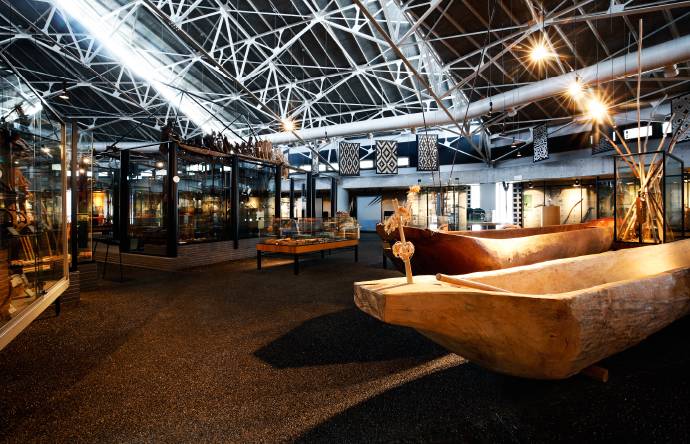
But this is the material culture of the Ainu. It’s clear that the boat is a remake, but it was made from photographs that have come down to our time.
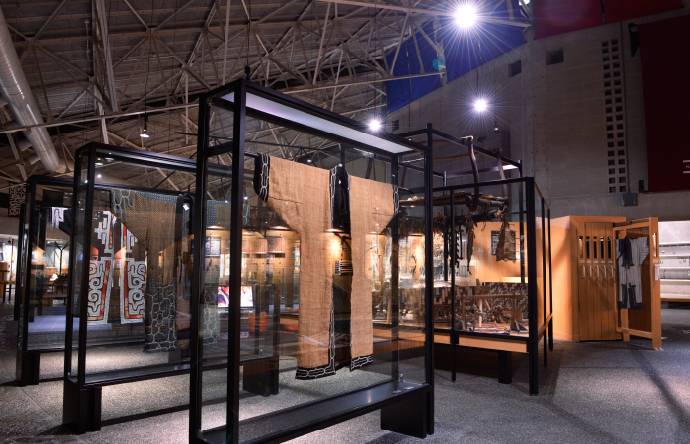
Clothing is displayed in such a way that it can be seen both in front and in the back.
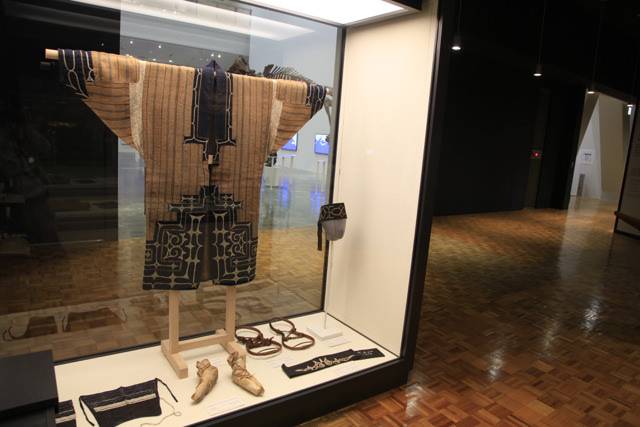
It must be emphasized that the national clothes of the Ainu cannot be confused with anything!
As for the Europeans, they encountered the Ainu only in the XNUMXth century and were also very struck by their appearance, which was not so similar to the appearance of the "native" Japanese people they already knew. And they, too, were not in a hurry to study them, confining themselves to the fact that a tribe of people unlike the Japanese lives on the northern Japanese island of Hokkaido, but it is not known where they came from.
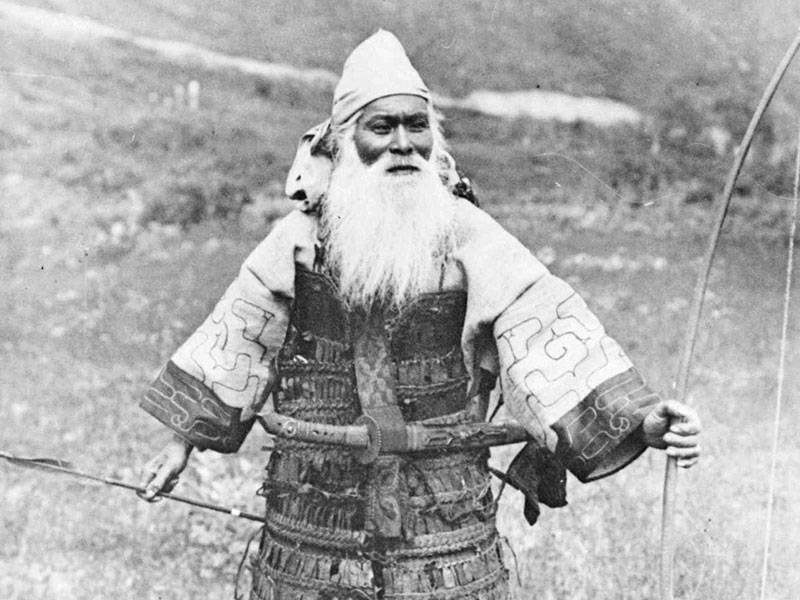
Photo of an Ainu with a bow and dressed in plate armor. They were most likely bony, tied with leather laces.
Only modern science has made it possible to determine both the initial region of origin of the ancestors of today's Ainu and the route of their advancement to the place of modern residence. Thus, an analysis of their haplogroups showed that 81,3% of the Ainu population belongs to the haplogroup D1a2, which was preceded by group D. Well, it is very ancient and appeared in Africa about 73 years ago. Then, in Asia, about 000 years ago, the D60 mutation occurred. A subclass of its D000a1b1 was identified in a representative of the Jomon culture, who lived about 2-1 years ago in Japan. Well, at present, subclades of haplogroup D are noted in Tibet, the Japanese and Andaman Islands. A study of the genetic diversity observed in subgroup D3 in Japan shows that this group was isolated here between 500 - 3 years ago. That is, the Ainu all this time did not particularly mix with anyone, and their contacts with newcomers "Japanese" are relatively recent in comparison with these millennia.
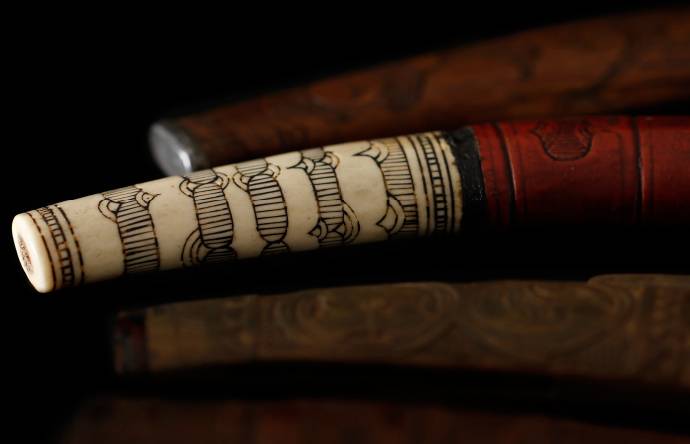
Patterns on clothes, patterns on the handles of knives ... Apparently, the Ainu greatly appreciated the beauty of the things around them
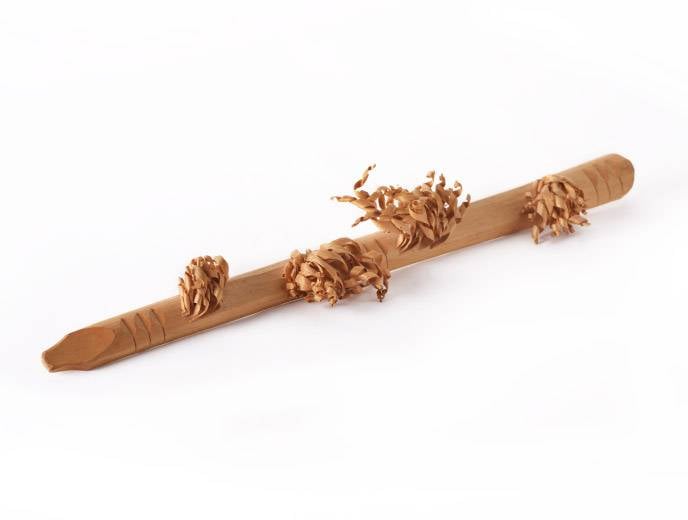
A very strange artifact is a wooden stick with planed shavings. Many such wands were sacrificed to the temples of spirits
It is believed that in their travels through Asia, the Ainu ancestors reached Japan some 13000 years ago and created the Jomon culture there. Toponyms of Ainu origin say that they once owned the island of Kyushu, and that they also lived in Kamchatka, but for some reason they did not move to America via Beringia.
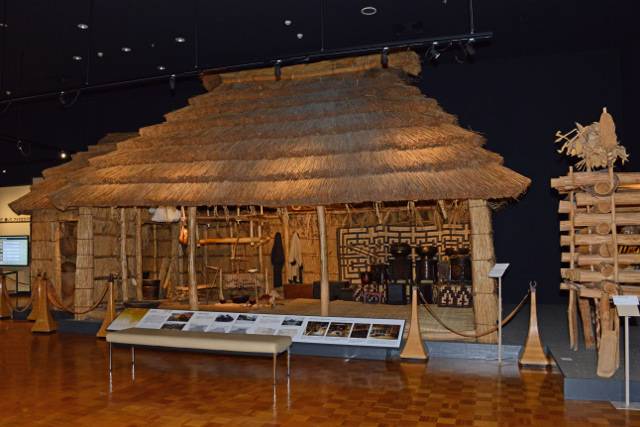
The Ainu house had an entrance in the east and did not have partitions inside. The dwelling on display here is a house restored on the orders of Mr. Yaichiro Hama (1916–1991), who was born and raised in Hirakaido, Iburi, Shiraoi. It was only slightly reduced to match the height of the ceilings of the museum. The hearth in the house occupies a central place, and there are places intended for sitting, sleeping and storing valuables or ritual instruments. They say that the coals in the hearth never cooled. Over time, the fire warmed the earth, and the walls and the roof of the reeds served as an excellent heater, protecting the inhabitants from the cold winters of Hokkaido
They did not engage in agriculture. And since hunting and gathering require large free spaces, the Ainu settlements were always far from one another. The Ainu religion is primitive animism and totemism, and the bear was considered the main totem animal. The Japanese even believed that the Ainu descended from a bear and therefore were not real people, which in their eyes was another reason why they could be killed. The hairiness of Ainu, their broad broad beards, which had to be maintained with special sticks during meals, and thick, curly hair on the head and body - all this terrified them. And here, in addition, is the cult of the bear, about which the Ainu themselves said that it was their ancestor!
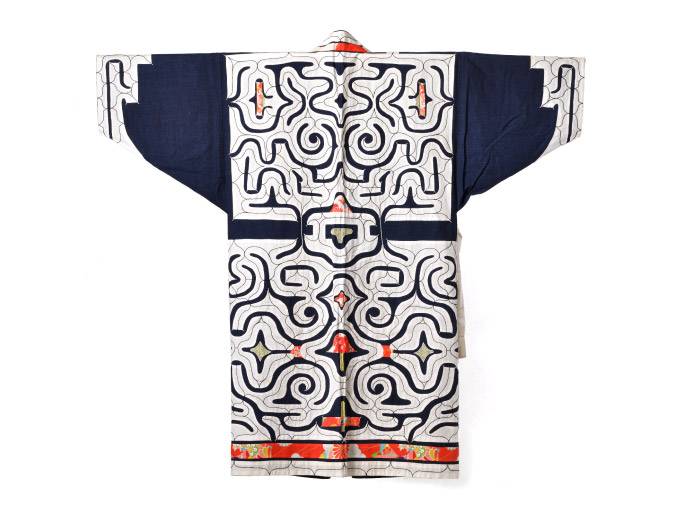
Kaparimi - ainu kimono with traditional embroidery
And about Ainu women, for example, such a story was told. They usually wore overalls with a red fabric apron on the front of the belt. And so when they went to pick raspberries and met a bear in the thicket, they waved at these aprons and shouted: “Bear, bear, go away, but have you seen this?” The bear saw, was scared and left!
At the same time, the Ainu were very afraid of snakes (although they were not killed). They simply believed that if a person was sleeping with his mouth open, a snake could crawl into it and drive him crazy.
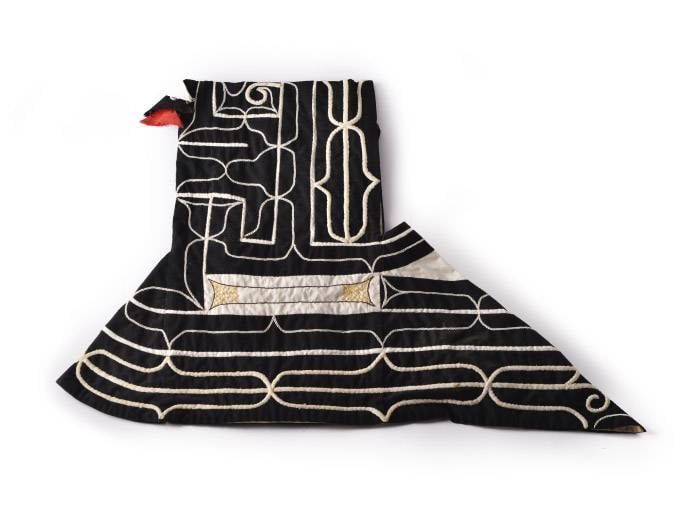
Embroidered hood
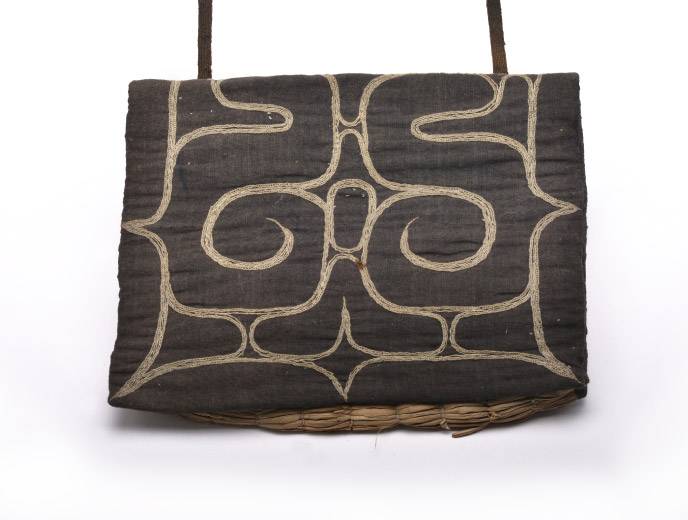
Bag for fire accessories
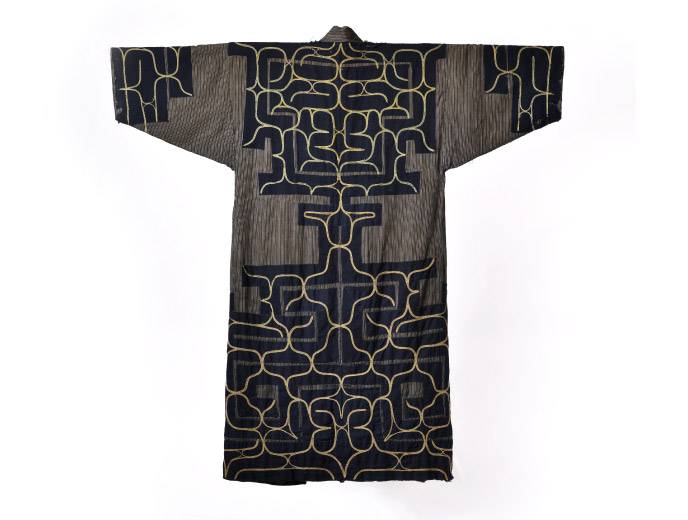
Another embroidered kimono
On the whole, both in appearance and in their customs, the aboriginal culture of Jomon and the culture of aliens from mainland Yayoi were extremely different from each other, which inevitably gave rise to their confrontation. But at the same time, the natives took over the metal from the aliens, and the aliens from the natives had horse riding skills in the mountains and, in fact, the cult of single soldiers, which later became the spiritual support of the Japanese samurai soldiers. And this is not surprising, because the confrontation of both of them lasted almost one and a half thousand years - a period more than sufficient for the interpenetration of even the most diverse cultures. Nevertheless, assimilation between them never happened, and the reason here again, most likely, was a purely ethnic factor.

Ainu Bow Arrow
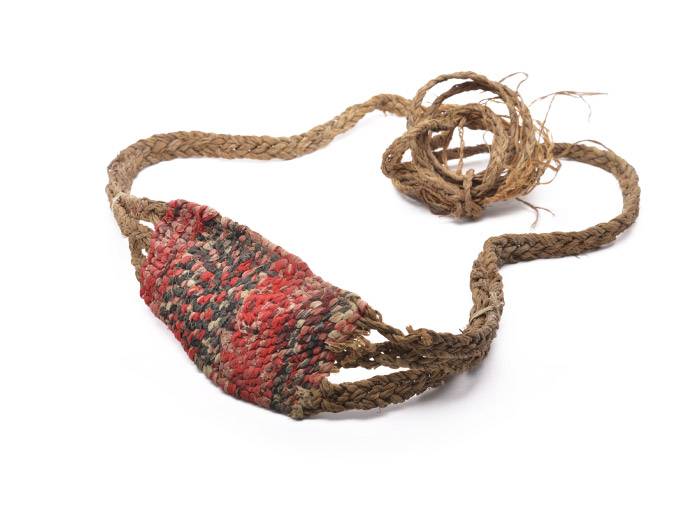
Wicker sling
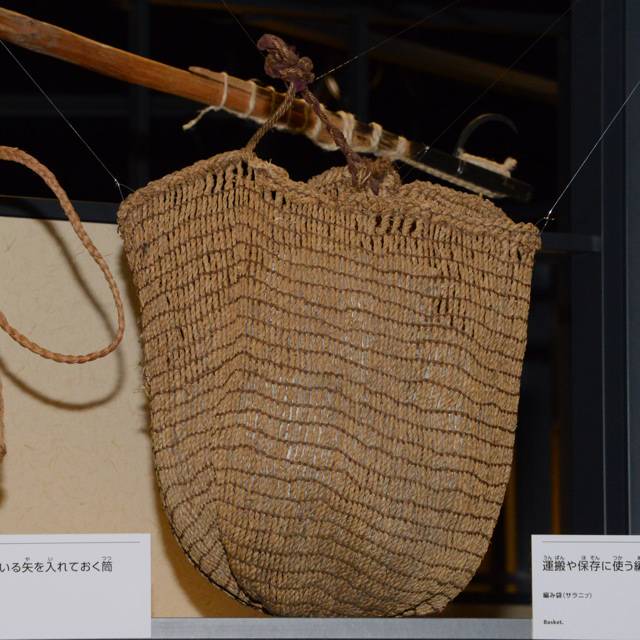
Saranip was a basket woven from tree bark and stems of various climbing plants. Due to the combination of different materials, the baskets were of various sizes and shapes. They were used to transport grain, for example, Japanese millet, wild plants and fish
The history of the Ainu is perhaps as tragic as the history of the American Indians. They were also driven into peculiar reservations, they were transported to the islands of the Kuril ridge, forced to engage in agriculture, that is, they broke their usual way of life. Rebellions against Japanese administration in Hokkaido and other islands crushed by force weapons. True, after the Meiji revolution, the Ainu began to build hospitals, canceled the most cruel decrees, but ... at the same time, they forbade men to wear their luxurious beards and women to have a traditional tattoo around their lips. That is, it was nothing more than an attempt on the traditional culture and its gradual destruction. True, according to the "Law on Patronage of the Aboriginal Population" adopted in 1899, each Ainu family was allocated a land plot with a 30-year exemption from land and local taxes and registration fees. Passing through the lands of the Ainu was possible only with the permission of the governor. Poor Ainu families were given seeds, and schools were being built in Ainu villages. However, on the whole, all this served one purpose: to make Aboriginal people live in Japanese. In 1933 they were converted to Japanese subjects with the assignment of Japanese surnames, while young Ainu were also given Japanese names. However, it must be said that the Ainu did not want to recognize themselves as Japanese for a very long time, they rejected Japanese culture, and came out with demands to create their own sovereign state.
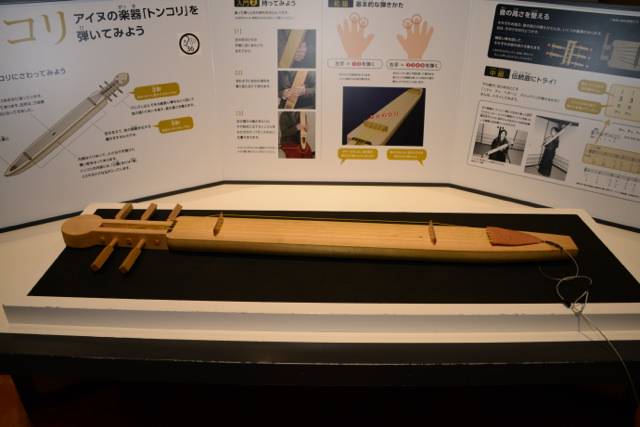
In the museum you can try playing the Tonkori - a five-stringed instrument, a traditional musical instrument of the Sakhalin Ainu. Gently pinch the strings and you will hear the sound they make. The display shows how tokors need to be kept and played on it.
Currently, there are about 25 Ainu in Japan, but no more than 000 people speak their native language, and it is gradually forgotten. And only on June 200, 6, by the decision of the Japanese parliament, the Ainu were recognized as an independent national minority, which, however, didn’t affect their lives in any particular way. But now their culture is wholly and completely placed at the service of the tourism industry in Japan. Figurines of a bear carved from wood are sold in Hokkaido in almost every shop, and even in museums without fail, although ethnographers know that in the religion of the Ainu there was a ban on the image of their animal totem. Dressing gowns, characteristic bags, wooden carved plates, and much more are produced. The Ainu museums in Hokkaido, with the most modern design, open one by one, typical Ainu houses and entire villages are built, holidays with music and dancing are held. So, apparently, the culture of the Ainu seems to be preserved. But it, like the culture of the North American Indians, has long been hit by the rink of modern civilization, and basically it meets its requirements, and not the Ainu culture.
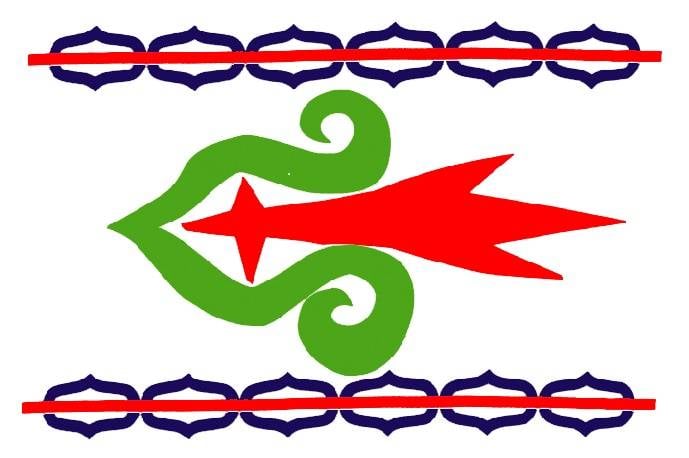
But this is the flag of the Kuril Ainu, which differs from the flag “just Ainu” in color (that blue!) And the image of a chain of islands along the edge. For centuries, the Kuril Islands belonged to the Ainu, they say, that is, both Russians and Japanese, when they argue about these islands, it should be borne in mind that we lived here long before they arrived. There you go!
The site administration and the author express their heartfelt gratitude to the Directorate of the Ainu Nibutani Museum in the city of Biratori and personally to Mr. Amy Hiroka for the opportunity to use photographs of their exhibits and information.
I must note that in my practice for the first time the administration of the museum, with which I contacted on the subject of obtaining permission to use his photographs, reacted to this in such a thorough way. An email address was requested to familiarize himself with the content of his materials, then the title of the article, my professional details, and also copies of borrowed photos. Only after that the contract was drawn up, which I signed, sent to the museum by e-mail, where it was stamped.
In this way, in fact, all the museums of the world should work. But it often happens like this: you ask permission and they answer you: ok, take it! Or do not answer at all. In the first case, this, of course, saves time; in the second, it is extremely impolite. As a result, I was once again convinced of the responsible and extremely conscientious attitude of the Japanese to their work. Well, the result of such an attitude is before you today.
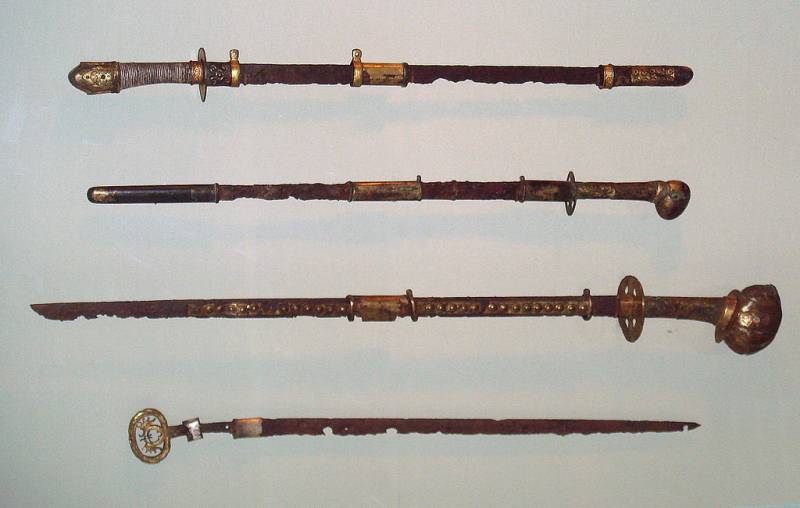
Information